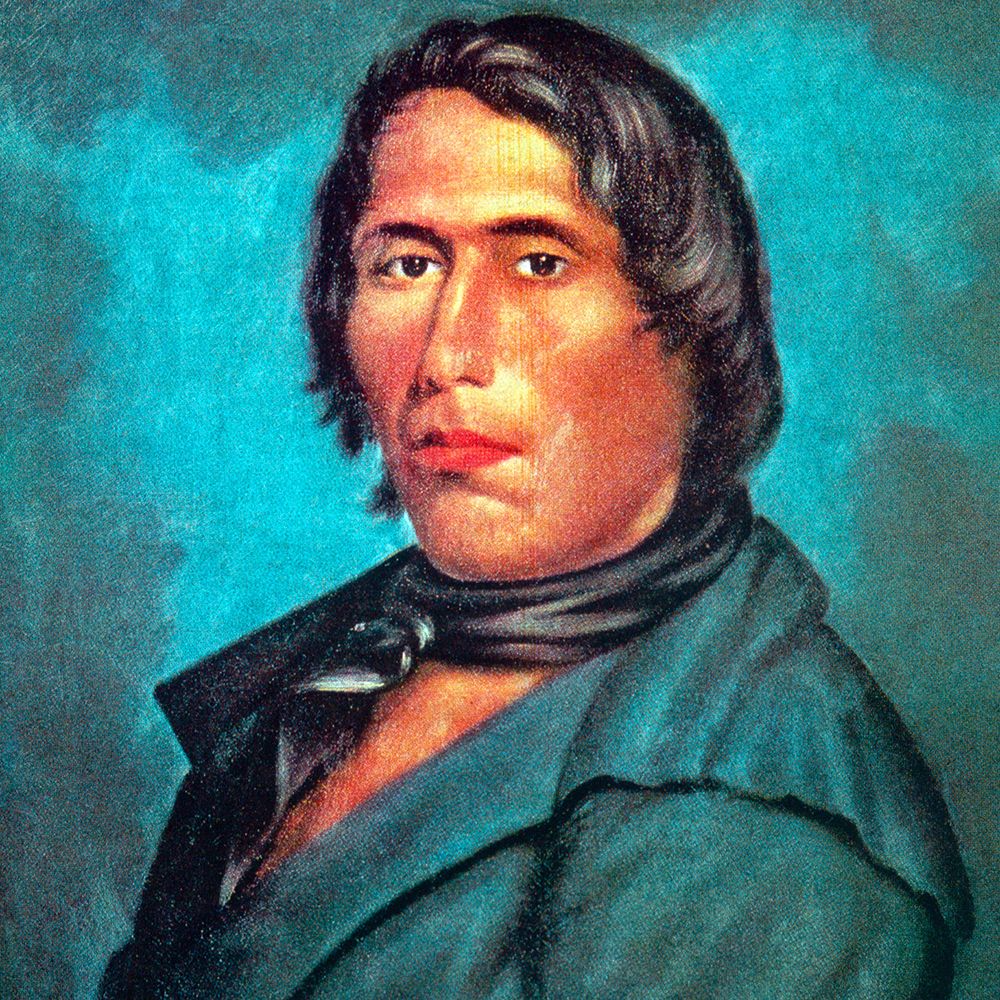You are viewing the article Tecumseh at Thptlaihoa.edu.vn you can quickly access the necessary information in the table of contents of the article below.

(1768-1813)
Who Was Tecumseh?
Tecumseh was a Shawnee Native American chief, born about 1768 south of present-day Columbus, Ohio. During the early 1800s, he attempted to organize a confederation of tribes to resist white settlement. During the War of 1812, Tecumseh and his followers joined the British to fight the United States. He was killed in the Battle of the Thames in Canada on October 5, 1813.
Early Years
Born about 1768 in south-central Ohio near present-day Chillicothe, Tecumseh grew up amidst the border warfare that ravaged the Ohio Valley in the last quarter of the 18th century. His father, Puckeshinwa, a minor war chief, was killed in the Battle of Point Pleasant during the French and Indian War. His mother, Methoataske, left him to be raised by his older sister, Tecumpease, as she migrated with other Shawnees to Missouri.
Young Warrior
During his teenage years, Tecumseh joined a confederation of Native Americans led by Mohawk chief Joseph Brant. Brant encouraged tribes to pool their resources and defend their territory against the white man’s encroachment. Tecumseh led a raiding party attacking white settlers’ boats making their way down the Ohio River and was successful in cutting off their access for a time. However, Tecumseh was appalled by the brutality displayed by both white and Native Americans, and after witnessing a white man burned at the stake, Tecumseh vehemently chastised his fellow tribesmen for their actions.
In 1791, under the leadership of Shawnee chief Blue Jacket, Tecumseh led a scouting party against U.S. General Arthur St. Clair at the Battle of the Wabash, where 952 of 1,000 American soldiers were killed. In June 1794, Tecumseh led an unsuccessful attack against Major General Anthony Wayne at Fort Recovery, and two months later, his force was decidedly defeated at the Battle of Fallen Timbers.
Tecumseh was so bitter about the defeat that he refused to attend the subsequent negotiations or to acknowledge the Treaty of Greenville. He sharply criticized the “peace” chiefs who signed away land that he believed wasn’t theirs to give, asserting that the land was like the air and water, a common possession of all Native Americans.
Brother
In 1808, Tecumseh traveled with a small contingency of a few hundred tribesmen, to what is now Indiana and joined his brother Tenskwatawa, who had recently become a prominent Native American religious leader known as the Prophet.
Using his superior oratory skills, over time Tecumseh transformed his brother’s religious following into a political movement, discouraging Native Americans from assimilation into the white world. Headquartered at Prophetstown, near the juncture of the Tippecanoe and Wabash rivers, Tecumseh began recruiting different tribes throughout the Northwest Territory and southern United States.
Battle of Tippecanoe
In the fall of 1811, while Tecumseh was in the South on a recruiting mission, Indiana governor William Henry Harrison moved a force of 1,000 men to Prophetstown and entrenched themselves on a nearby hill. On November 6, the Prophet sent a message asking to meet with Harrison. Then, during the early hours of November 7, the Tecumseh’s brother launched a sneak attack on his camp. In the ensuing Battle of Tippecanoe, the Native Americans were thrown back and the victorious Americans burned the town. In the aftermath, Tecumseh returned to try and rebuild his shattered confederacy.
War of 1812
On June 1, 1812, the United States Congress declared war on Great Britain, beginning the War of 1812. In the Northwest Territory, the different Native Americans tribes found their allegiances split. For his part, Tecumseh moved his small band of warriors to Michigan to assist British Major-General Sir Isaac Brock in the Siege of Detroit. As British forces were stationed just outside the range of the Americans’ guns, Tecumseh had his warriors repeatedly parade out from a nearby wooded area and circle back, making it appear that their numbers were much greater. Fearing a massacre, American commander Brigadier-General William Hull surrendered.
Death
In the spring of 1813, Tecumseh joined British Major-General Henry Procter, and together they led their respective forces in the Siege of Fort Meigs, which was commanded by Tecumseh’s old nemesis William Henry Harrison.
When Harrison’s forces counterattacked, Procter and Tecumseh retreated farther into Canada, to the Thames River, in present-day southern Ontario. Though Procter promised Tecumseh he would send reinforcements, they never showed up, and on October 5, 1813, Tecumseh’s small 500-man force was overrun by Harrison’s 3,000-man army and Tecumseh was killed.
The circumstances surrounding Tecumseh’s death and burial are unclear. At the time, there were several claims that one or another American soldier had killed him, though none of these claims has ever been confirmed. It is currently believed that Tecumseh’s body was carried off the field and secretly buried in an unmarked grave.
Tecumseh’s death marked the decline of Native American resistance in the Ohio River Valley and most of the middle and southern United States. Exhausted Native American tribes were subsequently moved west of the Mississippi River over the next several decades. During his life, Tecumseh’s political leadership, compassion and bravery attracted the respect of friends and foes alike, and in the time since, a mythology has developed around him that has transformed him into an American folk hero.
QUICK FACTS
- Name: Tecumseh
- Birth Year: 1768
- Birth State: Ohio
- Birth City: On the Scioto River, near Chillicothe Ohio
- Gender: Male
- Best Known For: Tecumseh, a Shawnee chief, opposed white settlement in the United States during the early 1800s. He was killed during the War of 1812.
- Industries
- War and Militaries
- Politics and Government
- Death Year: 1813
- Death date: October 5, 1813
- Death City: Moravian of the Thames
- Death Country: Canada
Fact Check
We strive for accuracy and fairness.If you see something that doesn’t look right,contact us!
CITATION INFORMATION
- Article Title: Tecumseh Biography
- Author: Biography.com Editors
- Website Name: The Biography.com website
- Url: https://www.biography.com/political-figures/tecumseh
- Access Date:
- Publisher: A&E; Television Networks
- Last Updated: May 12, 2021
- Original Published Date: April 2, 2014
Thank you for reading this post Tecumseh at Thptlaihoa.edu.vn You can comment, see more related articles below and hope to help you with interesting information.
Related Search:


